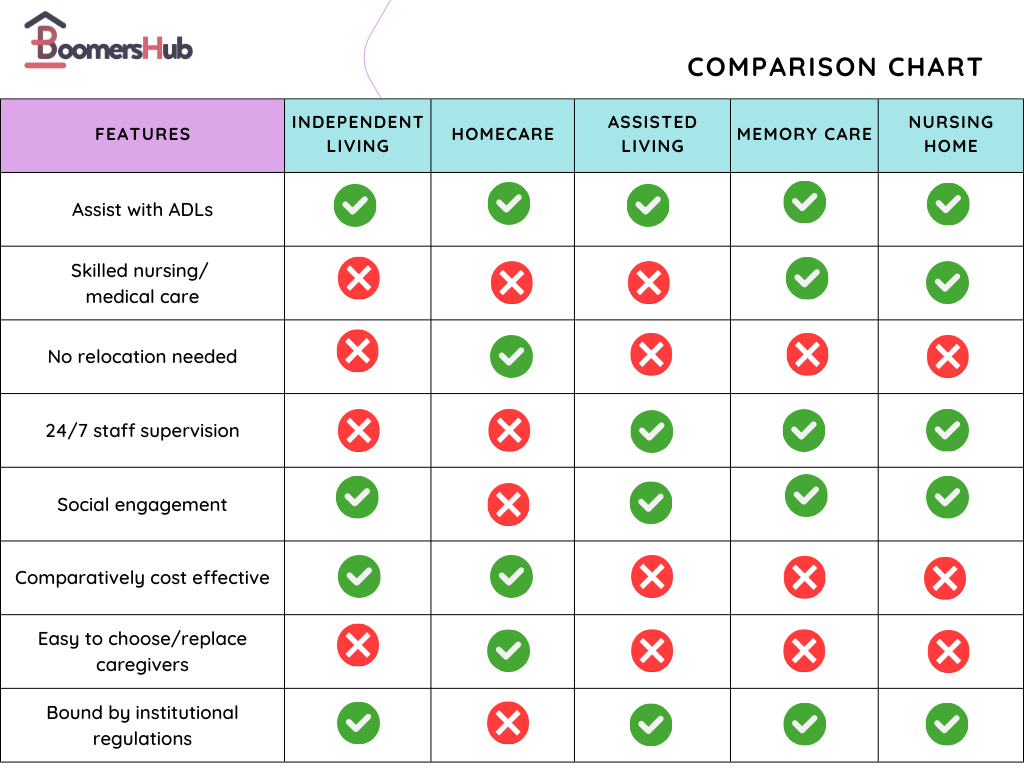Article Contents
After retiring from work, many older adults desire a simple and hassle-free life either on their own or with their spouse. Independent living offers the chance to reside in a retirement community with other seniors and like-minded individuals. It often involves downsizing from a larger home to a smaller apartment, condo, or retirement complex. In addition, independent living provides various services such as daily meals, housekeeping, laundry, maintenance, transportation, and recreational activities.
While it all sounds pretty exciting, independent living facilities are not the best option for older adults with health complications, mobility limitations, or needing 24/7 supervision. Fortunately, there are several alternatives they can choose from. This blog will check out some of the independent living alternatives and the benefits they provide. So, read on!
What are the pros and cons of independent living?
Independent living offers older adults the perfect mix of autonomy and comfort. While it can be a desirable option for some individuals, there are some pros and cons of independent living.
Pros
- Cost-effectiveness: Independent living is much cheaper than nursing homes or memory care facilities.
- Convenience and amenities: Many facilities offer housekeeping, laundry, transportation, and other services that can make life easier for residents.
- Community and socialization: Independent living facilities typically offer a range of social activities and events, which can help seniors stay active and engaged.
- Safety and security: Most retirement communities have security measures and emergency response to ensure the safety of residents.
Cons
- Lack of medical care: While some independent living may have on-site medical staff, most do not provide medical care beyond basic first aid.
- Isolation: While socialization is a pro for many residents, some may feel lonely or isolated if they don’t connect with other residents.
- Limited independence: While residents have more freedom than they would in a nursing home or assisted living facility, they may still have restrictions on their activities or behavior.
- Lack of privacy: While some independent living facilities offer private apartments, others may have shared living spaces or require residents to share a room.
What are the independent living alternatives?
As previously mentioned, there are other options available for seniors requiring additional assistance and attention apart from independent living. Here are the most popular independent living alternatives:
1. Independent living vs Homecare
Homecare is by far the most common alternative to independent living facilities. Older adults who want to stay in their homes while receiving assistance with daily tasks can consider this option. Homecare provides a range of services, including help with personal care, household chores, and medication management.
But it’s not just about practical assistance – homecare can also provide companionship and emotional support. Besides, homecare costs less than independent living facilities and provides a higher degree of flexibility and freedom while choosing doctors or caregivers.
With homecare, your loved ones can receive the assistance they need while still enjoying the familiarity and warmth of their own home. It’s a win-win situation!
2. Independent living vs Assisted Living
For the elderly who want to maintain their independence but need assistance with daily living activities, assisted living can be a great option. Assisted living offers round-the-clock supervision and assistance with daily activities such as bathing, dressing, eating, etc. In addition, residents have access to social activities and On-site amenities such as fitness centers, game rooms, community gardens, etc.
Though assisted living is more expensive than independent living, it provides a higher level of care and support for seniors who need it. For example, physical and occupational therapy, wound care, medication management, and more. It can be helpful for seniors with chronic health conditions that require ongoing care.
Overall, assisted living provides older adults the support and care they need to maintain their independence and quality of life.
3. Independent living vs Memory Care
Memory care can be an alternative to independent living for seniors with memory impairments. In a memory care facility, residents receive round-the-clock professional care from trained caregivers specializing in memory care. In addition, these communities are designed with safety features such as secured entrances and exits and alarmed doors and windows. That helps to prevent residents from wandering and getting lost.
In addition, memory care facilities provide a structured routine that includes daily activities and events. This helps to keep residents engaged which can help to decelerate the progression of dementia or Alzheimer’s.
4. Independent living vs Nursing Home
As people age, they may find that living independently is no longer viable due to various health issues. In such cases, nursing homes can be an appropriate alternative. Nursing homes offer round-the-clock medical care and supervision to residents from trained medical professionals. They are there to ensure residents’ safety and well-being and create personalized care plans that meet their unique needs.
Apart from medical care, nursing homes also offer various amenities and services to make your life easier and more enjoyable. For example, many nursing homes offer their residents pet therapy, arts and crafts classes, and fitness programs. Besides, there are various nursing home food options and recreational activities available.

Independent living alternatives
Some other alternatives to independent living facilities
Apart from these four independent living alternatives, there are some other senior care options available. Let’s check them out!
1. Continuing Care Retirement Communities (CCRCs)
Continuing Care Retirement Communities (CCRCs) are another popular independent living alternative. These communities offer a range of living options, including independent living, assisted living, and nursing care, all on one campus. This allows seniors receive the care they need as their needs change over time.
One of the primary benefits of CCRCs is the peace of mind they provide. Seniors can move into a community knowing they can receive the care they need without having to move again. Additionally, CCRCs can offer a sense of community and belonging, which can be especially important for seniors who may feel isolated.
2. Respite care
Respite care is a kind of short-term care that offers temporary relief to family caregivers. This option is highly beneficial for individuals who care for family members with cognitive impairments or other chronic conditions and need a break from their caregiving duties.
Respite care can be provided at home or in a facility, and the duration of care can range from just a few hours to several weeks.
3. Aging in place
Aging in place involves staying at home and making modifications to accommodate your changing needs. For example, installing grab bars in bathrooms, replacing doorknobs with lever handles, and adding ramps to entrances can make it easier for seniors to move around their homes safely.
Additionally, technology devices can be used to enhance safety and security, such as installing smart home appliances that can monitor activity and send alerts in case of an emergency.
4. Senior Co-housing
Senior co-housing is a relatively new independent living alternative that is gaining popularity. It involves a group of seniors coming together to build and manage a community of private homes or apartments that share common spaces, such as gardens, kitchens, and recreation rooms. Older adults have their own living space, but also have access to communal areas and can work together to maintain the community.
Final thoughts
As you can see, there are various independent living alternatives available for seniors who prefer to live on their own terms. From aging in place to assisted living, to senior cohousing, each option offers unique benefits and drawbacks. So, it is essential to choose the one that best suits their needs and preferences.
We hope this blog has provided you with valuable information and insights about senior living alternatives. We encourage you to explore all the options and take the time to make an informed decision. With the right resources, support, and planning, you can enjoy a fulfilling and independent lifestyle for years to come!
Related articles:
- Alternatives to assisted living: what other senior care options are available?
- Nursing home alternatives
- What are the alternatives to memory care?
- Homecare alternatives: What other senior care options are available?
FAQs
Who should move to an independent living facility?
If you or a loved one is considering moving to an independent living facility, the following individuals may benefit from this type of living arrangement:
- Seniors who are capable of living on their own but want to downsize their living space and get rid of housekeeping hassles
- Individuals who want to live in a community with others their age and have access to social activities and events
- People who want the security of living in a community with staff available to respond to emergencies
What is the minimum age to live in independent living?
The minimum age to live in independent living varies depending on the specific community or facility. However, in general, most independent living communities require residents to be at least 55 years old.

